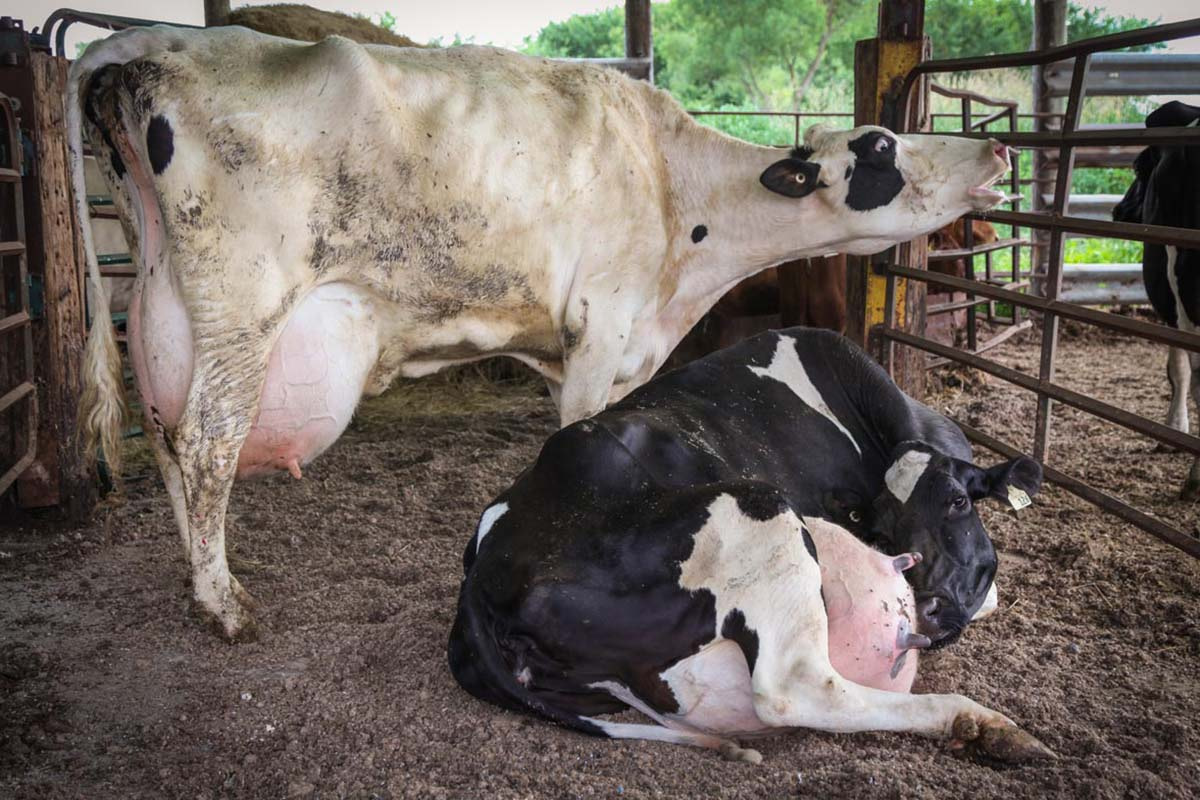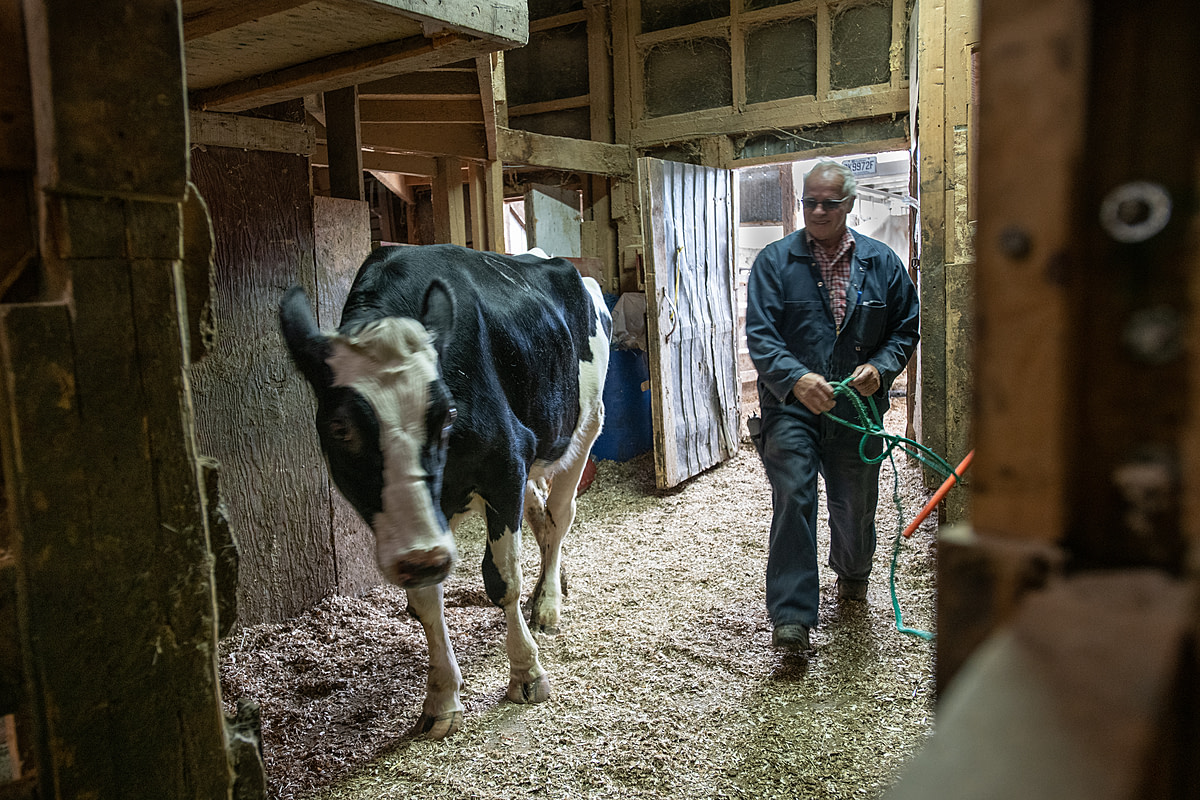An extremely thin cow stands in a large dairy farm. Quebec, Canada, 2022.
Jo-Anne McArthur / We Animals
While working with World Animal Protection for their latest report on Canadian dairy cows – a population of almost one million – our team of photojournalists documented how these cows are treated at farms and during transportation. This treatment is a far cry from the image the industry wants consumers to have of happy cows treated well.
Photographers/Videographers: Existence, Jo-Anne McArthur, Julie LP, Louise Jorgensen
The report, “Milking the Cow: The Fate of Canadian Cull Dairy Cows,” uncovers a troubling pattern of sick or injured end-of-life (“cull”) dairy cows being sent to slaughter when they aren’t fit for transport. This World Milk Day on June 1, originally intended to celebrate milk, our visuals show the ways that Canadian dairy is failing its cows.
“Farm animals deserve to be treated with dignity and must be protected by meaningful welfare standards, and it’s clear that the system is failing dairy cows. The inspection reports indicate an unacceptable pattern of neglect and lack of accountability which is in keeping with previous research on the subject…The status quo has led to an unacceptable level of suffering for dairy cows as they approach end-of-life.” ― Lynn Kavanagh, Farming Campaign Manager, World Animal Protection
An injured dairy cow looks up from the floor of a transport truck arriving at a Toronto-area slaughterhouse. Canada, 2021.
Louise Jorgensen / Animal Sentience Project / We Animals
A dairy cow stands inside a restraint while she receives an annual hoof trimming at a dairy farm in Quebec. It is necessary for every cow’s hooves to be trimmed so they do not become overgrown, but it can be a very stressful experience for each animal since the cows are forcibly restrained for approximately 15 minutes inside a specialized hoof trimming chute. Canada, 2022.
Julie LP / We Animals
A young calf on a dairy farm in Quebec drinks milk inside a dispensing station. She licks her lips and reaches her mouth upwards, exhibiting a desire to suckle something other than an artificial teat. Canada, 2022.
Julie LP / We Animals
Cows are milked as they stand in a row inside the milking parlour of a large dairy farm in Quebec. Canada, 2022.
Jo-Anne McArthur / We Animals
Male and occasionally female calves are grown as veal, while most females are raised to become dairy cows themselves. Dairy farms have little use for male calves, and if not slated to be sold or raised for veal, these calves are often killed shortly after birth by either firearm or blunt force. In previous reporting, we documented the efforts to rescue male calves in Vermont destined to be shot.
A resistant cow is forcibly administered an oral calcium supplement at a dairy farm in Quebec. The employee at the farm uses a balling gun (bolus gun) of almost one meter in length to force the supplement down into her throat. In order to keep her still, the employee has pulled this cow’s head back by inserting his fingers into her nostrils. Canada, 2022.
Julie LP / We Animals
As of 2022, the province of Québec remains Canada’s largest keeper of dairy cows and milk producers, and while the number of milk-producing farms has been declining since 1971, the size of the farms continues to grow. Despite a recent update to Canada’s Code of Practice for Dairy Cattle, which outlines welfare improvements to be implemented on dairy farms across the country, Canada still has no legal requirement for dairy cows to be allowed outside, and as farms consolidate and grow in size, an unfortunate change for the country’s dairy cows is that, more often than not, cows are being kept indoors year-round.
Boxes of milk in front of a cow on display at the Royal Agricultural Winter Fair in Toronto. Canada, 2014.
Jo-Anne McArthur / We Animals
In 2022, our photojournalists visited a sale yard and auction site in a small Canadian town that hosts domesticated animal sales every week. Built over a century ago, the facility is filled with winding chutes and swinging and sliding doors through which the animals are moved. Animals are transported the day of sale, sometimes the day before, and are held together in pens until the auction begins.
Only animals who can still walk off the trucks are legally able to be sold at auction, where staff hit them with objects so prospective buyers know they can still move. The animals sold at this particular auction site are typically considered “spent” and will go to slaughter, and are generally thin, ill, have engorged udders, mastitis or are no longer able to carry a pregnancy and produce milk.
During transport to auction and onto slaughter cull dairy cows face a number of hardships, including simply being unfit to transport.
The current system for cull cows in Canada means many animals will be sent to auction to be sold and then further transported, sometimes long distances, to slaughter, including to plants in the US. Despite the Canadian Veterinary Medical Association advising against the long-distance transport of cull dairy cows who are not fit for travel, there are few plants in Canada that accept these animals, forcing farmers to send their cows hundreds to thousands of kilometres away. Some animals have been transported as far as Texas to be slaughtered, making for a long and arduous journey.
An injured cow lays on the floor of a transport truck at a Toronto-area slaughterhouse. The crowded conditions of the truck cause the other animals to trample her. Canada, 2021.
Louise Jorgensen / Animal Sentience Project / We Animals
The Canadian Dairy Commission is a powerful government Crown corporation and deserves to be held accountable for its neglect. World Animal Protection is calling on all stakeholders in the food system to scale up regulatory inspections, strengthen enforcement, and incorporate accountability regimes in supply chains to ensure cull dairy cows do not suffer en route to slaughter.
Read and share the full report: Milking the Cow: The Fate of Canadian Cull Dairy Cows
Photographers/Videographers: Existence, Jo-Anne McArthur, Julie LP, Louise Jorgensen
Data sources: Sentient Media / BC SPCA / Canadian Veterinary Medical Association
Explore and download these visuals via our stock platform or view our full collection of visuals from inside Canada’s dairy industry.

















